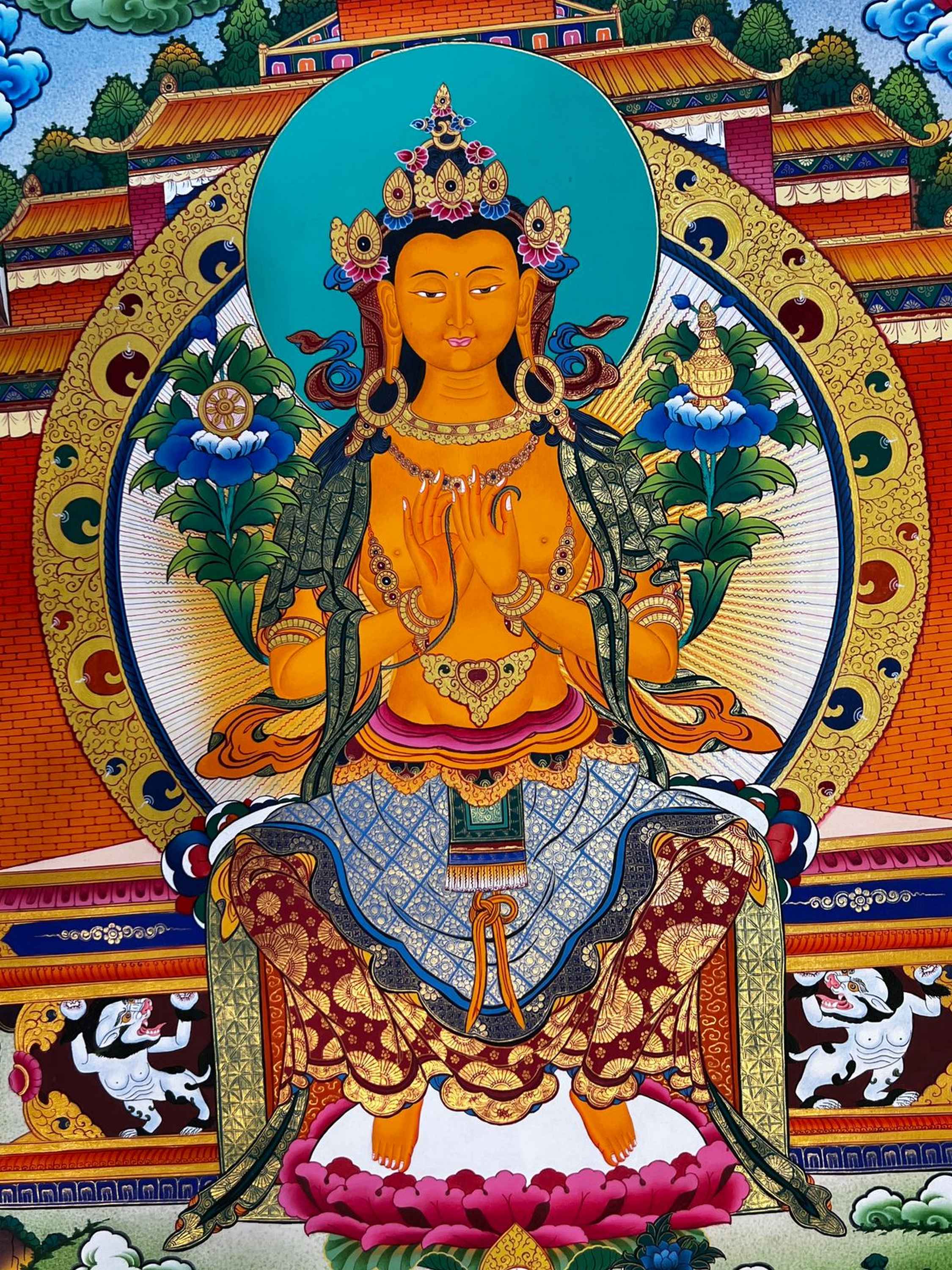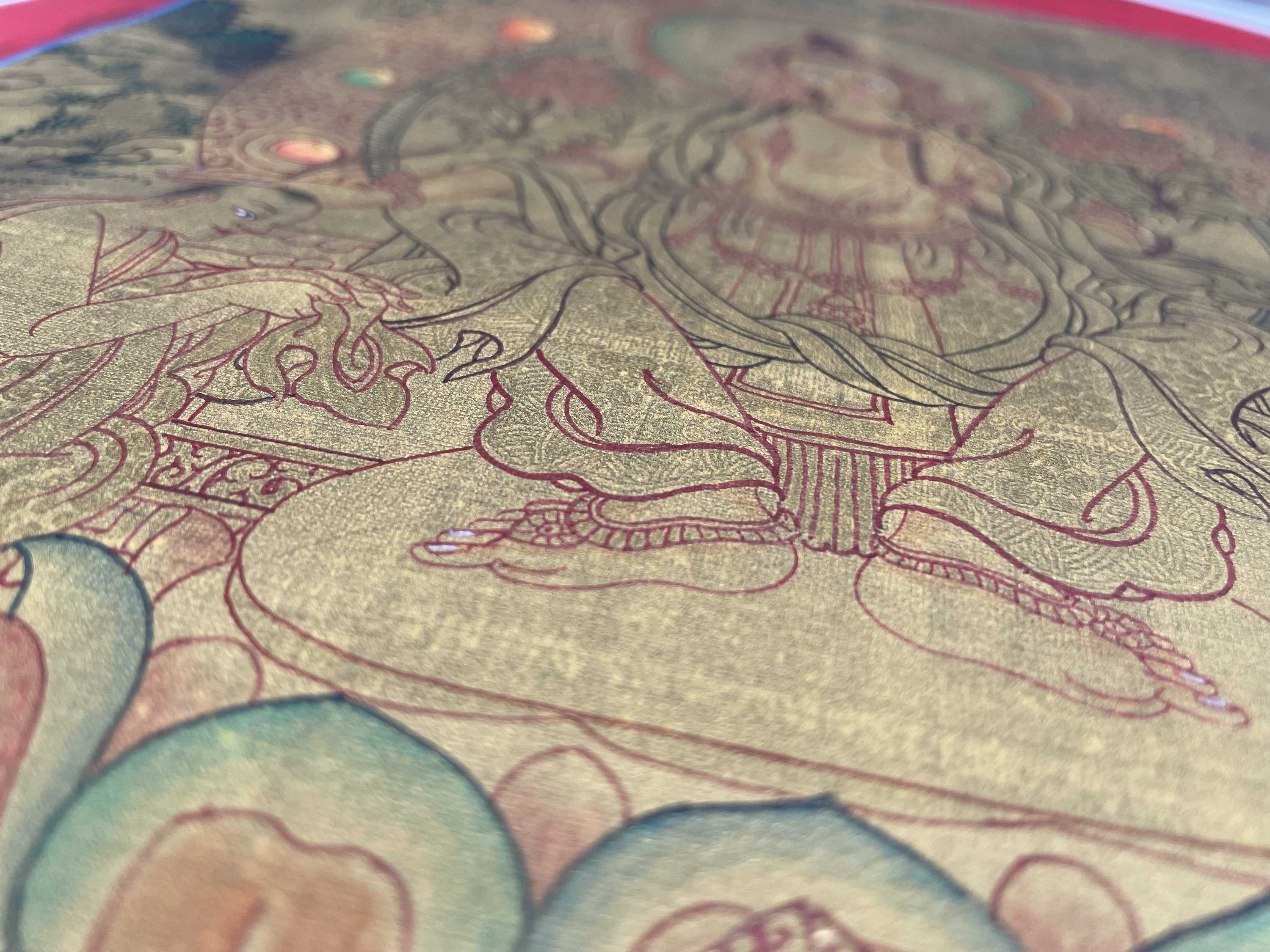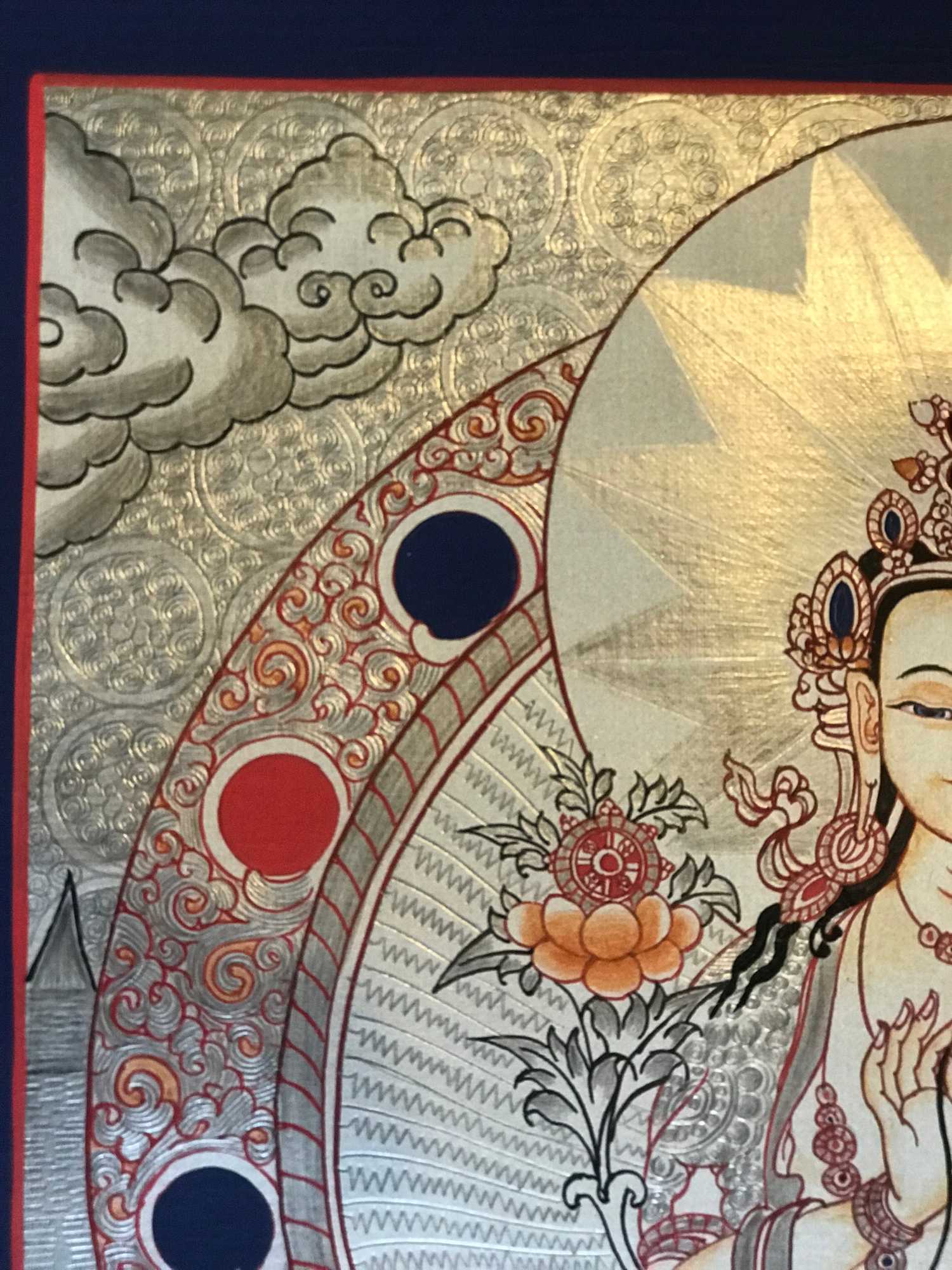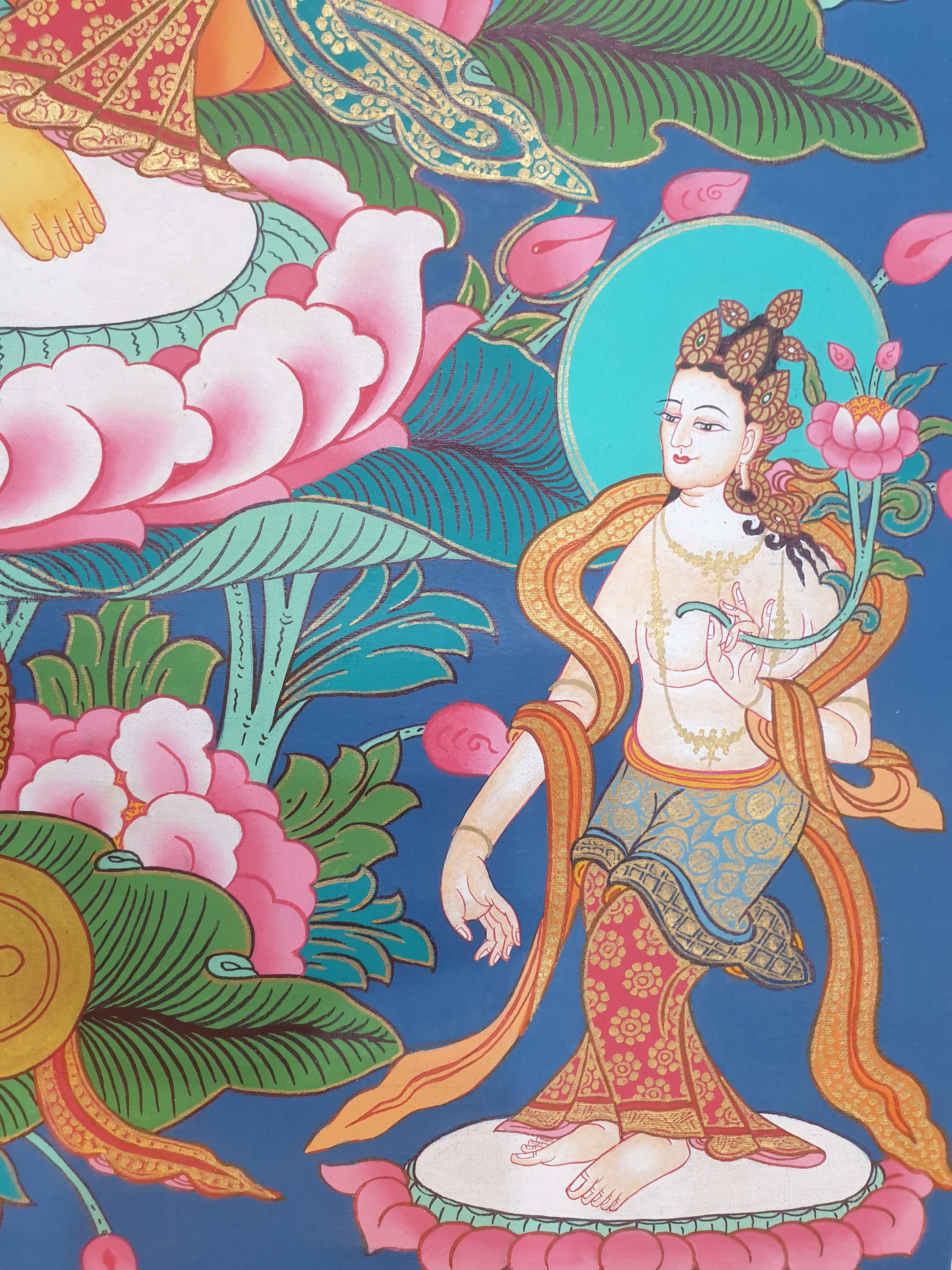Code
HCS14985
Weight
100 gm / 0.22 lbs
Size
Height
70cm (28") Width
50cm (20") Material
Cotton Canvas
Availability
Available
Date Added
2018-03-09 12:30:00
Note : We used to sell this product 7 years ago so it may no longer be in our stock.
It is possible that we still have it with our suppliers but the price could be different from before.
Feel free to order. We will verify availability and inform you promptly.
It is possible that we still have it with our suppliers but the price could be different from before.
Feel free to order. We will verify availability and inform you promptly.

Safe Payment
We accept Paypal, Money Transfer, Bank Transfer
Confidence
Protection covers your purchase and personal data.
Worldwide Delivery
We ship Worldwide, except Russia.Shipping cost US$25.2 for upto 0.5 kgs

Hotline
Talk to help line for your question on 9841267335Vajrapani : Brief Introduction
Vajrapaṇi is one of the earliest bodhisattvas of Mahayana Buddhism. He is the protector and guide of the Buddha, and rose to symbolize the Buddha's power. Vajrapani was used extensively in Buddhist iconography as one of the three protective deities surrounding the Buddha. Each of them symbolizes one of the Buddha's virtues: Manjusri (the manifestation of all the Buddhas' wisdom), Avalokitesvara (the manifestation of all the Buddhas' compassion) and Vajrapani (the manifestation of all the Buddhas' power). Furthermore, Vajrapani is one of the earliest Dharmapalas and one of the rare Buddhist deities to be worshiped in the original Zen Buddhism of the Shaolin Temple, Tibetan Buddhism, and even Pure Land Buddhism (where he is known as Mahasthamaprapta). Manifestations of Vajrapani can also be found in many Buddhist temples in Japan as Dharma protectors called Nio. Read More . . .
Vajrapaṇi is one of the earliest bodhisattvas of Mahayana Buddhism. He is the protector and guide of the Buddha, and rose to symbolize the Buddha's power. Vajrapani was used extensively in Buddhist iconography as one of the three protective deities surrounding the Buddha. Each of them symbolizes one of the Buddha's virtues: Manjusri (the manifestation of all the Buddhas' wisdom), Avalokitesvara (the manifestation of all the Buddhas' compassion) and Vajrapani (the manifestation of all the Buddhas' power). Furthermore, Vajrapani is one of the earliest Dharmapalas and one of the rare Buddhist deities to be worshiped in the original Zen Buddhism of the Shaolin Temple, Tibetan Buddhism, and even Pure Land Buddhism (where he is known as Mahasthamaprapta). Manifestations of Vajrapani can also be found in many Buddhist temples in Japan as Dharma protectors called Nio. Read More . . .
Manjushri : Brief Introduction
Manjushree is a Sanskrit word meaning 'gentle glory'. In Sanskrit, "shree" means 'glorious' or 'honorable'. His name signifies one who embodies enlightened wisdom. He confers mastery of the Dharma, wisdom, and eloquence and teaches the path of a bodhisattva in the Mahayana tradition. Read More . . .
Manjushree is a Sanskrit word meaning 'gentle glory'. In Sanskrit, "shree" means 'glorious' or 'honorable'. His name signifies one who embodies enlightened wisdom. He confers mastery of the Dharma, wisdom, and eloquence and teaches the path of a bodhisattva in the Mahayana tradition. Read More . . .
Green Tara : Brief Introduction
Samaya Tara, popularly known as Green Tara. She is represented in a royal ease posture with her left leg bent her left leg overstepping the main lotus and resting on a blue lotus ready to get up and offer assistance to those in need. She is portrayed with maroon Buddhist robes and jewelry. The earrings represent patience, understanding, and renunciation. The diadem with five jewels represents the transmutation of the five delusions into the Five Buddha Wisdoms. She is shown with a benevolent countenance seated upon a white moon disk which is associated with special restorative nectar associated with the naval chakra center. In Buddhists, the moon symbolizes the wisdom aspect which when coupled with compassion leads to Sakyamuni Buddha's enlightenment. Her right hand is gracefully lowered in Varada mudra, the boon-granting gesture. Read More . . .
Samaya Tara, popularly known as Green Tara. She is represented in a royal ease posture with her left leg bent her left leg overstepping the main lotus and resting on a blue lotus ready to get up and offer assistance to those in need. She is portrayed with maroon Buddhist robes and jewelry. The earrings represent patience, understanding, and renunciation. The diadem with five jewels represents the transmutation of the five delusions into the Five Buddha Wisdoms. She is shown with a benevolent countenance seated upon a white moon disk which is associated with special restorative nectar associated with the naval chakra center. In Buddhists, the moon symbolizes the wisdom aspect which when coupled with compassion leads to Sakyamuni Buddha's enlightenment. Her right hand is gracefully lowered in Varada mudra, the boon-granting gesture. Read More . . .
Amitabha Buddha : Brief Introduction
Amitabha is head of the Lotus Family, one of oldest & significant of the Five Buddha Families. This family represents love, purity, compassion & peace. Amitabha Purelandis a place of infinite bliss & boundless light. He will guide you along a path of simplicity and purity towards such a place where you can find inner contentment. Amitabha will help you overcome addictions and cravings. Read More . . .
Amitabha is head of the Lotus Family, one of oldest & significant of the Five Buddha Families. This family represents love, purity, compassion & peace. Amitabha Purelandis a place of infinite bliss & boundless light. He will guide you along a path of simplicity and purity towards such a place where you can find inner contentment. Amitabha will help you overcome addictions and cravings. Read More . . .
White Tara : Brief Introduction
White Tara is a revered figure in Buddhist mythology, often depicted as a compassionate and serene goddess. She embodies peace and emanates loving compassion, bringing grace and dignity to various situations. White Tara's presence encourages the emergence of goodness and positive outcomes in all circumstances. She upholds the Four Measureless States, which include Loving Kindness, Compassion, Sympathetic Joy, and Equanimity, encompassing past, present, and future circumstances. Additionally, White Tara is associated with the bestowing of longevity, symbolizing a long and healthy life. Her essence embodies the ideals of compassion and benevolence, making her a significant figure in Buddhist worship and spiritual practices. Read More . . .
White Tara is a revered figure in Buddhist mythology, often depicted as a compassionate and serene goddess. She embodies peace and emanates loving compassion, bringing grace and dignity to various situations. White Tara's presence encourages the emergence of goodness and positive outcomes in all circumstances. She upholds the Four Measureless States, which include Loving Kindness, Compassion, Sympathetic Joy, and Equanimity, encompassing past, present, and future circumstances. Additionally, White Tara is associated with the bestowing of longevity, symbolizing a long and healthy life. Her essence embodies the ideals of compassion and benevolence, making her a significant figure in Buddhist worship and spiritual practices. Read More . . .
Introduction to Thangka
A thangka, also known as tangka, thanka, or tanka, is a vibrant and intricate Tibetan Buddhist painting that serves as a visual representation of spiritual teachings. Crafted with meticulous detail on cotton or silk appliqué, thangkas depict a wide range of subjects including Buddhist deities, sacred scenes, mandalas, and narrative stories. These sacred artworks are traditionally kept unframed and rolled up for storage, resembling ancient scrolls. To protect their delicate nature, thangkas are mounted on textile backings and often adorned with a silk cover on the front. Proper preservation in dry environments is crucial to maintain the integrity and longevity of the silk. Read More . . .
A thangka, also known as tangka, thanka, or tanka, is a vibrant and intricate Tibetan Buddhist painting that serves as a visual representation of spiritual teachings. Crafted with meticulous detail on cotton or silk appliqué, thangkas depict a wide range of subjects including Buddhist deities, sacred scenes, mandalas, and narrative stories. These sacred artworks are traditionally kept unframed and rolled up for storage, resembling ancient scrolls. To protect their delicate nature, thangkas are mounted on textile backings and often adorned with a silk cover on the front. Proper preservation in dry environments is crucial to maintain the integrity and longevity of the silk. Read More . . .
Brief Introduction :
NAMO RATNA TRAYAYA / NAMO BHAGAVATE
SHAKYAMUNIYE / TATHAGATAYA / ARHATE SAMYAKSAM
BUDDHAYA / TADYATHA / OM AJITE AJITE APARAJITE /
AJITAÃCHAYA HA RA HA RA MAITRI AVALOKITE KARA KARA
MAHA SAMAYA SIDDHI BHARA BHARA MAHA BODHI MANDA
BIJA SMARA SMARA AHSMA KAM SAMAYA BODHI BODHI
MAHA BODHI SVAHA
Benefit Maitreya represents the future state of love emanating from great universal bliss. This is embodied by the Adi Buddha Samantabhadra & gained by using the tools of Vajrayana 'magical' Buddhism & can be realised from the adamantine truth of emptiness embodied by Adi Buddha Vajradhara. The name Maitreya is derived from the Sanskrit word maitri stemming from the old Pali word metta meaning 'loving-kindness' related to Pali word mitta meaning 'friend'. When Maitreya becomes fully realised, he will preside over the Ketumati Pure Land, an earthly paradise. Maitreya is the embodiment of a future state of loving kindness, sympathetic joy, equanimity & compassion which create great bliss & conscious love.
Iconography :Maitreya resides in Tushita heaven accessible through mediation & sits on a throne seat with two snow lions [Skt. Singhasana] in the frieze. Snow lions are the national symbol of Tibet. Tushita is alluded to by the mountainous landscapes swirling cumulous cloudbanks. His wears a green upper garment of Indian royalty from his shoulders, maroon Buddhist trousers with silk brocade, a blue Mantrayana apron and a sash representing the Himalayan Rainbow [Five Pure Lights of the Mahabhuta]. The small stupa shape in his headdress represents the stupa of the Buddha Sakyamuni's relics to help him identify it when his turn comes to lay claim to his succession. The light green khata loose around his waist is a traditional ceremonial scarf symbolizing purity.
He holds both hands in front of his heart in a hand position signifying the turning the wheel of Buddhist teachings [Skt. dharmachakra mudra]. The left hand holds the stem of a blue lotus or 'night lotus'[Skt. Utpala]. The word utpala means to 'burst open'. This supports an auspicious golden wheel [Skt. Chakra] which represents change, universal cycles of existence such as the changing of the hands of a watch, the seasons of the year, the earth & moon revolving around the sun and these three in turn revolving with other planets. All is in flux, forever changing. Each forward Turning of the wheel represents a movement of Buddhist teaching. This is usually called the turning of the Wheel of Dharma. The eight spokes symbolising the noble Eightfold Path of right Thought [mirror], right Insight or View [mustard seed], right Thought, right Action [bilva fruit], right Effort [durva grass], right Livelihood [curds] and right Contemplation [vermilion powder].
The right hand holds another lotus stem supporting a water pot [Skt. Kalasa] which traditionally contains the primeval water carried by the creator Brahma. This water of creation or water of life [don't confuse with the blue nectar of immortality]represents the pure conscious mind and its ability to regenerate and purify the conscious mind. The water pot is one of the eight auspicious symbols [Skt. Astamangalas] where the word asta means eight. The green nimbus around his head represents his cosmic nature. He is surrounded by a blooming 'pink lotus' [Skt. Kamala] and an unopened bud on her left hand. The Pink lotus blossoms represents the present love and the red unopened bud future love & yet to be born Buddhas. The future here also refers to beneficial changes circumstances that will help bring about. Maitreya's elongated earlobes represent patience; his topknot [Skt. Ushnisa] his abandonment of worldly possessions, the dot [Skt.urna] on his brow on the command chakra [Skt.ajna] represents his transcendent wisdom. The thin blue aureole around his body signifies the highest level of understanding.
Commentary :He holds both hands in front of his heart in a hand position signifying the turning the wheel of Buddhist teachings [Skt. dharmachakra mudra]. The left hand holds the stem of a blue lotus or 'night lotus'[Skt. Utpala]. The word utpala means to 'burst open'. This supports an auspicious golden wheel [Skt. Chakra] which represents change, universal cycles of existence such as the changing of the hands of a watch, the seasons of the year, the earth & moon revolving around the sun and these three in turn revolving with other planets. All is in flux, forever changing. Each forward Turning of the wheel represents a movement of Buddhist teaching. This is usually called the turning of the Wheel of Dharma. The eight spokes symbolising the noble Eightfold Path of right Thought [mirror], right Insight or View [mustard seed], right Thought, right Action [bilva fruit], right Effort [durva grass], right Livelihood [curds] and right Contemplation [vermilion powder].
The right hand holds another lotus stem supporting a water pot [Skt. Kalasa] which traditionally contains the primeval water carried by the creator Brahma. This water of creation or water of life [don't confuse with the blue nectar of immortality]represents the pure conscious mind and its ability to regenerate and purify the conscious mind. The water pot is one of the eight auspicious symbols [Skt. Astamangalas] where the word asta means eight. The green nimbus around his head represents his cosmic nature. He is surrounded by a blooming 'pink lotus' [Skt. Kamala] and an unopened bud on her left hand. The Pink lotus blossoms represents the present love and the red unopened bud future love & yet to be born Buddhas. The future here also refers to beneficial changes circumstances that will help bring about. Maitreya's elongated earlobes represent patience; his topknot [Skt. Ushnisa] his abandonment of worldly possessions, the dot [Skt.urna] on his brow on the command chakra [Skt.ajna] represents his transcendent wisdom. The thin blue aureole around his body signifies the highest level of understanding.
It is up to all sentient beings to turn the wheel Maitreya is a future Buddha, an enlightened person who will appear on Earth, achieve complete enlightenment, and teach the pure dharma which are the principles of Buddhism.
Mantra Maitreya Buddha
NAMO RATNA TRAYAYA / NAMO BHAGAVATE
SHAKYAMUNIYE / TATHAGATAYA / ARHATE SAMYAKSAM
BUDDHAYA / TADYATHA / OM AJITE AJITE APARAJITE /
AJITAÃCHAYA HA RA HA RA MAITRI AVALOKITE KARA KARA
MAHA SAMAYA SIDDHI BHARA BHARA MAHA BODHI MANDA
BIJA SMARA SMARA AHSMA KAM SAMAYA BODHI BODHI
MAHA BODHI SVAHA


![Buddhist Hand Painted Thangka Of Maitreya Buddha [future Buddha] Surrounded By White Tara, Green Tara, Amitabha Buddha, Manjushri And Vajrapani [tibetan Style], [painting]](https://handicraftseller.com/uploads/pics/product/thumb/2018/03/14985_0.jpg)
![Buddhist Hand Painted Thangka Of Maitreya Buddha [future Buddha] Surrounded By White Tara, Green Tara, Amitabha Buddha, Manjushri And Vajrapani [tibetan Style], [painting]](https://handicraftseller.com/uploads/pics/product/thumb/2018/03/14985_1.jpg)
![Buddhist Hand Painted Thangka Of Maitreya Buddha [future Buddha] Surrounded By White Tara, Green Tara, Amitabha Buddha, Manjushri And Vajrapani [tibetan Style], [painting]](https://handicraftseller.com/uploads/pics/product/thumb/2018/03/14985_2.jpg)
![Buddhist Hand Painted Thangka Of Maitreya Buddha [future Buddha] Surrounded By White Tara, Green Tara, Amitabha Buddha, Manjushri And Vajrapani [tibetan Style], [painting]](https://handicraftseller.com/uploads/pics/product/thumb/2018/03/14985_3.jpg)
![Buddhist Hand Painted Thangka Of Maitreya Buddha [future Buddha] Surrounded By White Tara, Green Tara, Amitabha Buddha, Manjushri And Vajrapani [tibetan Style], [painting]](https://handicraftseller.com/uploads/pics/product/thumb/2018/03/14985_4.jpg)
![Buddhist Hand Painted Thangka Of Maitreya Buddha [future Buddha] Surrounded By White Tara, Green Tara, Amitabha Buddha, Manjushri And Vajrapani [tibetan Style], [painting]](https://handicraftseller.com/uploads/pics/product/thumb/2018/03/14985.jpg)










 of Maitreya Buddha,
of Maitreya Buddha,  of Maitreya Buddha,
of Maitreya Buddha,  of
of  of
of  of
of  of
of  of Medicine Buddha, White Tara, Aparimita
of Medicine Buddha, White Tara, Aparimita  of Medicine Buddha, White Tara, Aparimita
of Medicine Buddha, White Tara, Aparimita  of Maitreya Buddha" title="Tibetan Thangka
of Maitreya Buddha" title="Tibetan Thangka  of Maitreya Buddha" title="Tibetan Thangka
of Maitreya Buddha" title="Tibetan Thangka  Real Gold" title="Maitreya Buddha Tibetan Hand Painted Thangka
Real Gold" title="Maitreya Buddha Tibetan Hand Painted Thangka  Real Gold" title="Maitreya Buddha Tibetan Hand Painted Thangka
Real Gold" title="Maitreya Buddha Tibetan Hand Painted Thangka  of Maitreya Buddha, Real 24k Gold,
of Maitreya Buddha, Real 24k Gold,  of Maitreya Buddha,
of Maitreya Buddha,  of Maitreya Buddha,
of Maitreya Buddha,  of Maitreya Buddha,
of Maitreya Buddha,  of Maitreya Buddha,
of Maitreya Buddha,